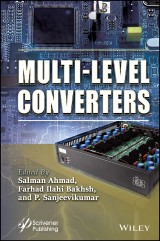Details
Multilevel Converters
1. Aufl.
|
168,99 € |
|
| Verlag: | Wiley |
| Format: | |
| Veröffentl.: | 21.06.2024 |
| ISBN/EAN: | 9781394167364 |
| Sprache: | englisch |
| Anzahl Seiten: | 400 |
DRM-geschütztes eBook, Sie benötigen z.B. Adobe Digital Editions und eine Adobe ID zum Lesen.
Beschreibungen
<p><b>Discover the deep insights into the operation, modulation, and control strategies of multilevel converters, alongside their recent applications in variable speed drives, renewable energy generation, and power systems.</b> <p>Multilevel converters have gained attention in recent years for medium/high voltage and high power industrial and residential applications. The main advantages of multilevel converters over two level converters include less voltage stress on power semiconductors, low dv/dt, low common voltage, reduced electromagnetic interference, and low total harmonics distortion, among others. Better output power quality is ensured by increasing the number of levels in the synthesized output voltage waveform. Several multilevel topologies have been reported in the literature, such as neutral point clamped (NPC), flying capacitor (FC), cascaded H-bridge (CHB), hybrid cascaded H-bridge, asymmetrical cascaded H-bridge, modular multilevel converters (MMC), active neutral point clamped converters (ANPC), and packed U-cell type converters and various reduced device counts and a reduced number of source-based topologies have been proposed in literature. <p>The multilevel converter, although a proven and enabling technology, still presents numerous challenges in topologies, modulation, and control, as well as in need-based applications. Since multilevel converters offer a wide range of possibilities, research and development in the areas of multilevel converter topologies, modulation, and control in various applications are still growing. To further improve multilevel converter energy efficiency, reliability, power density, and cost, many research groups across the world are working to broaden the application areas of multilevel converters and make them more attractive and competitive compared to classic topologies. <p><i>Multilevel Converters</i> intends to provide deep insight about multilevel converter operation, modulation, and control strategies and various recent applications of multilevel converters such as in variable speed drives, renewable energy generation, and power systems.
<p><b>Salman Ahmad, PhD</b> is an assistant professor in the Department of Electrical Engineering, Islamic University of Science and Technology, India. He worked as a Lecturer with Debre Berhan University and Arba Minch University in Ethiopia from 2012 to 2015 and is an associate member of the Institutions of Engineers and the Institute of Electrical and Electronics Engineers. Additionally, he has published more than 20 technical papers in different journals and conference proceedings, contributed four chapters in edited books, and received four research grants from various government agencies. <p><b>Farhad Ilahi Bakhsh, PhD</b> is an assistant professor in the Department of Electrical Engineering, National Institute of Technology Srinagar, Jammu and Kashmir, India. He has developed five new systems, four of which have been officially published by patent offices, and has more than 50 published papers in reputed national and international journals and conferences. During his PhD, he developed a new method for grid integration for wind energy generation systems which has been recognized worldwide. <p><b>P. Sanjeevikumar, PhD</b> has been a faculty member in the Department of Energy Technology, Aalborg University, Esbjerg, Denmark since 2018. He has authored over 300 scientific papers. Additionally, he is a fellow of the Institution of Engineers, India, the Institution of Electronics and Telecommunication Engineers, India, and the Institution of Engineering and Technology, U.K.
<p><b>Discover the deep insights into the operation, modulation, and control strategies of multilevel converters, alongside their recent applications in variable speed drives, renewable energy generation, and power systems.</b> <p>Multilevel converters have gained attention in recent years for medium/high voltage and high power industrial and residential applications. The main advantages of multilevel converters over two level converters include less voltage stress on power semiconductors, low dv/dt, low common voltage, reduced electromagnetic interference, and low total harmonics distortion, among others. Better output power quality is ensured by increasing the number of levels in the synthesized output voltage waveform. Several multilevel topologies have been reported in the literature, such as neutral point clamped (NPC), flying capacitor (FC), cascaded H-bridge (CHB), hybrid cascaded H-bridge, asymmetrical cascaded H-bridge, modular multilevel converters (MMC), active neutral point clamped converters (ANPC), and packed U-cell type converters and various reduced device counts and a reduced number of source-based topologies have been proposed in literature. <p>The multilevel converter, although a proven and enabling technology, still presents numerous challenges in topologies, modulation, and control, as well as in need-based applications. Since multilevel converters offer a wide range of possibilities, research and development in the areas of multilevel converter topologies, modulation, and control in various applications are still growing. To further improve multilevel converter energy efficiency, reliability, power density, and cost, many research groups across the world are working to broaden the application areas of multilevel converters and make them more attractive and competitive compared to classic topologies. <p><i>Multilevel Converters</i> intends to provide deep insight about multilevel converter operation, modulation, and control strategies and various recent applications of multilevel converters such as in variable speed drives, renewable energy generation, and power systems.
Diese Produkte könnten Sie auch interessieren:

Introduction to Strain-Based Structural Health Monitoring of Civil Structures

von: Branko Glisic

76,99 €

Introduction to Strain-Based Structural Health Monitoring of Civil Structures

von: Branko Glisic

76,99 €

Entwicklung eines FEM-Beinmodells zur Simulation der Interaktion mit einer Prothese

von: Guangxu Chen

36,99 €














